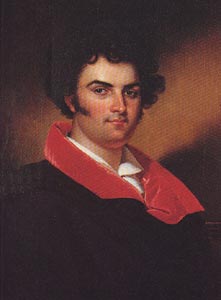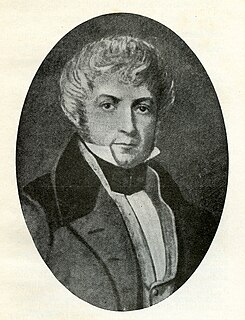Related Research Articles
A soprano ([soˈpraːno]) is a type of classical female singing voice and has the highest vocal range of all voice types. The soprano's vocal range (using scientific pitch notation) is from approximately middle C (C4) = 261 Hz to "high A" (A5) = 880 Hz in choral music, or to "soprano C" (C6, two octaves above middle C) = 1046 Hz or higher in operatic music. In four-part chorale style harmony, the soprano takes the highest part, which often encompasses the melody. The soprano voice type is generally divided into the coloratura, soubrette, lyric, spinto, and dramatic soprano.
The musical term alto, meaning "high" in Italian, historically refers to the contrapuntal part higher than the tenor and its associated vocal range. In 4-part voice leading alto is the second highest part, sung in choruses by either low women's or high men's voices. In vocal classification these are usually called contralto and male alto or countertenor.
A tenor is a type of classical male singing voice whose vocal range lies between the countertenor and baritone voice types. It is the highest male chest voice type. The tenor's vocal range extends up to C5. The low extreme for tenors is widely defined to be B2, though some roles include an A♭2 (two A♭s below middle C). At the highest extreme, some tenors can sing up to the second F above middle C (F5). The tenor voice type is generally divided into the leggero tenor, lyric tenor, spinto tenor, dramatic tenor, heldentenor, and tenor buffo or spieltenor.
A contralto is a type of classical female singing voice whose vocal range is the lowest female voice type.
A mezzo-soprano or mezzo (; Italian: [ˌmɛddzosoˈpraːno]; meaning "half soprano") is a type of classical female singing voice whose vocal range lies between the soprano and the contralto voice types. The mezzo-soprano's vocal range usually extends from the A below middle C to the A two octaves above (i.e. A3–A5 in scientific pitch notation, where middle C = C4; 220–880 Hz). In the lower and upper extremes, some mezzo-sopranos may extend down to the F below middle C (F3, 175 Hz) and as high as "high C" (C6, 1047 Hz). The mezzo-soprano voice type is generally divided into the coloratura, lyric, and dramatic mezzo-soprano.
A coloratura soprano is a type of operatic soprano voice that specializes in music that is distinguished by agile runs, leaps and trills.
The tenore contraltino is a specialized form of the tenor voice found in Italian opera around the beginning of the 19th century, mainly in the Rossini repertoire, which rapidly evolved into the modern 'Romantic' tenor. It is sometimes referred to as tenor altino in English books.

Giovanni Battista Rubini was an Italian tenor, as famous in his time as Enrico Caruso in a later day. His ringing and expressive coloratura dexterity in the highest register of his voice, the tenorino, inspired the writing of operatic roles which today are almost impossible to cast. As a singer Rubini was the major early exponent of the Romantic style of the bel canto era of Vincenzo Bellini and Gaetano Donizetti.

Antonio Tamburini was an Italian operatic baritone.

Domenico Donzelli was an Italian tenor with a robust voice who enjoyed an important career in Paris, London and his native country during the 1808-1841 period.
A voice type is a group of voices with similar vocal ranges, capable of singing in a similar tessitura, and with similar vocal transition points (passaggi). Voice classification is most strongly associated with European classical music, though it, and the terms it utilizes, are used in other styles of music as well.

Gilbert-Louis Duprez was a French tenor, singing teacher and minor composer who famously pioneered the delivery of the operatic high C from the chest. He also created the role of Edgardo in the popular bel canto-era opera Lucia di Lammermoor in 1835.
A spinto soprano is a type of operatic soprano voice that has the limpidity and easy high notes of a lyric soprano, yet can be "pushed" on to achieve dramatic climaxes without strain. This type of voice may possess a somewhat darker timbre, too, than the average lyric soprano. It generally uses squillo to "slice" through the sound of a full orchestra, rather than singing over the orchestra like a true dramatic soprano.
There is no authoritative system of voice classification in non-classical music as classical terms are used to describe not merely various vocal ranges, but specific vocal timbres unique to each range. These timbres are produced by classical training techniques with which most popular singers are not intimately familiar, and which even those that are do not universally employ them.

Dino Borgioli was an Italian lyric tenor. Praised by critics for his musicianship, he was particularly associated with roles in operas composed by Mozart, Rossini, and Donizetti.
A lyric soprano is a type of operatic soprano voice that has a warm quality with a bright, full timbre that can be heard over an orchestra. The lyric soprano voice generally has a higher tessitura than a soubrette and usually plays ingenues and other sympathetic characters in opera. Lyric sopranos have a range from approximately middle C (C4) to "high D" (D6). This is the most common female singing voice. There is a tendency to divide lyric sopranos into two groups: light and full.
Baritenor is a portmanteau (blend) of the words "baritone" and "tenor." It is used to describe both baritone and tenor voices. In Webster's Third New International Dictionary it is defined as "a baritone singing voice with virtually a tenor range." However, the term was defined in several late 19th century and early 20th century music dictionaries, such as The American History and Encyclopedia of Music, as "a low tenor voice, almost barytone [sic]."
Falsettone is a term used in modern Italian musicology to describe a vocal technique used by male opera singers in the past, in which the fluty sounds typical of falsetto singing are amplified by using the same singing technique used in the modal voice register. The result is a bright, powerful tone, often very high-pitched, although the sound is still different from and more feminine than what is produced by the modal voice. The term falsettone is also used for the mixed vocal register that can be achieved using this technique.

Manuel del Pópulo Vicente Rodriguez García was a Spanish opera singer, composer, impresario, and singing teacher.
References
Notes
Citations
- ↑ "The Tenor Voice – Lyrischer (hoher) tenor (c to c)", ipasource.com
- ↑ Soreanu, Cristina. "Nineteenth Century’s Donizettian Singers and their Contribution to the Development of the Vocal Technique." Bulletin of the Transilvania University of Braşov, Series VIII: Performing Arts 2 (2014): 124–130.
- 1 2 Enrico Stinchelli (2002). Le stelle della lirica: i grandi cantanti della storia dell'opera. Gremese Editore. pp. 19–. ISBN 978-88-8440-192-2.
- ↑ Kent Carlson (2000). The leggero tenor in opera: 1754–1793. Garri Editions.
- ↑ Richard Boldrey; Janet Bookspan; Carol Kimball (1992). Singers' edition, operatic arias: soubrette. Pst. ISBN 9781877761034.
- ↑ George Henry Hubert Lascelles Earl of Harewood (2000). Opera. Rolls House Publishing Company.
- ↑ Walker, Evan. "The Fable of Adolphe Nourrit." Journal of Singing 64.4 (2008): 411.
- ↑ Nicholas Till (18 October 2012). The Cambridge Companion to Opera Studies. Cambridge University Press. pp. 131–. ISBN 978-0-521-85561-7.
- ↑ Storia della musica. Editoriale Jaca Book. 1995. pp. 296ff. ISBN 978-88-16-43917-7.
- ↑ May, Joshua M. "The Rise of the Tenor Voice in the Late Eighteenth Century: Mozart’s Opera and Concert Arias." (2014).
- ↑ Brent, Joseph (18 December 2014). Giovanni Paolo Bottesini as a composer for the tenor voice, as seen in his writing for Roberto Stagno, Angelo Masini, and Alberto Bozetti (PDF) (DMA). University of Georgia.
- ↑ Michael Edward Henstock (20 September 1990). Fernando De Lucia: son of Naples : 1860–1925. Duckworth. ISBN 978-0-7156-2325-1.
- ↑ Dan H. Marek (6 June 2013). Giovanni Battista Rubini and the Bel Canto Tenors: History and Technique. Scarecrow Press. pp. 8ff. ISBN 978-0-8108-8668-1.
- ↑ Opera. Rolls House Publishing Company. March 2008.
- ↑ Opera. Rolls House Publishing Company. March 2008. pp. 127ff.
- ↑ Arthur Elson (1915). The Book of Musical Knowledge: The History, Technique, and Appreciation of Music, Together with Lives of the Great Composers, for Music-lovers, Students and Teachers. Houghton Mifflin.
- ↑ Richard Boldrey; Robert Caldwell; Roger Pines; Janet Bookspan (1 June 1992). Singers' edition, operatic arias: lyric soprano, light lyric soprano. Pst. ISBN 9781877761027.
- ↑ Helena Matheopoulos (1 November 1986). Divo: great tenors, baritones, and basses discuss their roles . Harper & Row. ISBN 978-0-06-015634-3.
- 1 2 Dan Marek (2007). Singing: The First Art . Scarecrow Press. pp. 37ff. ISBN 978-0-8108-5711-7.
- ↑ Francois Nouvion (October 2012). Asile Hereditaire: The Life and Career of John O'Sullivan. Xlibris Corporation. pp. 411ff. ISBN 978-1-4771-5123-5.
- ↑ Naomi Adele André (1 January 2006). Voicing Gender: Castrati, Travesti, and the Second Woman in Early-nineteenth-century Italian Opera . Indiana University Press. pp. 127ff. ISBN 0-253-34644-4.
- 1 2 Laura Williams Macy (2008). The Grove Book of Opera Singers. Oxford University Press. pp. 136ff. ISBN 978-0-19-533765-5.
- ↑ Dorothea Link (2011). Arias for Vincenzo Calvesi: Mozart's first Ferrando. A-R Editions. pp. 15ff. ISBN 978-0-89579-717-9.
- ↑ Herbert Kupferberg (8 November 1988). The book of classical music lists. Penguin Books. ISBN 978-0-14-011188-0.
- ↑ Enciclopedia della musica. Rizzoli Ricordi. 1972.
- ↑ Roger Alier Aixalà; Roger Alier (1 January 2002). Historia de la ópera. Ediciones Robinbook. pp. 180ff. ISBN 978-84-95601-66-7.
- ↑ Friedrich Lippmann (1972). Bericht. Böhlau Verlag. ISBN 978-3-412-96772-7.
- ↑ BBC Music Magazine. BBC Magazines. 2008.
- ↑ Robert Cannon (16 February 2012). Opera. Cambridge University Press. pp. 391ff. ISBN 978-0-521-76302-8.
- ↑ Helena Matheopoulos (28 September 1999). The great tenors: from Caruso to the present. Vendome Press. ISBN 9780865652033.
- ↑ John Sullivan Dwight (1865). Dwight's Journal of Music. D.L. Balch. pp. 128ff.
- ↑ Gustav Kobbé (3 October 2014). The Complete Opera Book (Illustrated). B & R Samizdat Express. ISBN 978-1-4554-4648-3.
- ↑ RM, rassegna musicale italiana. Rassegna musicale italiana. 1997.